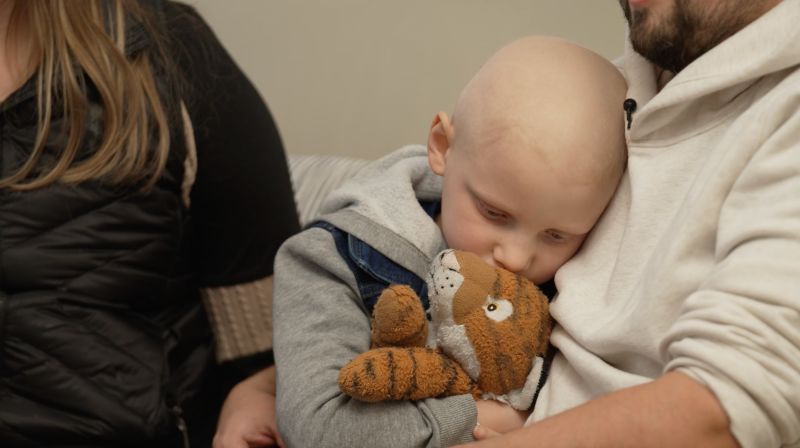A kindergartner’s hopes for beating cancer are tied to federal grants now on the chopping block

There are some things that Aly and Cody Vela have slowly grown accustomed to, like the three-hour drive from their home in Muskegon, Michigan, to Ann Arbor and sleeping on a mattress topper on a hospital room’s pull-out couch.
But other things never seem to get easier. For Aly, in particular, the recent nights away from their almost 2-year-old daughter, Alyssa, have been tough to stomach.
“We missed her first steps, talking and all of those milestones,” Aly said.
The reason is a cancer diagnosis that was given to Aly and Cody’s 6-year-old son, Cailen, when he was just 4 years old. The discovery of the disease in Cailen’s ear canal upended the Vela family’s lives. After Cailen got through the initial treatment of chemo- and proton-therapy, the cancer came back last fall in a rare relapse.
And now — on top of all of that — money that helps doctors and scientists across the country figure out a path forward for Cailen appears to be at risk.
A proposal to slash the research funding distributed by the National Institutes of Health (NIH) as part of President Donald Trump’s reshaping of the federal government and its spending was blocked after virtually the entire academic and medical communities across the country went to court seeking emergency help.
But with a final outcome unknown, the Velas have been left wondering what bad news they might get about Cailen’s future treatment.
A new baby and a new diagnosis
Aly was pregnant with Alyssa when she took Cailen for a routine pediatrician’s visit in November 2022. The doctor thought he might have an ear infection. But a biopsy led to the heart-stopping diagnosis: a rare and aggressive form of cancer called embryonal rhabdomyosarcoma.
Cailen, then a bubbly preschooler with floppy blond hair, was immediately referred to specialists at the University of Michigan and CS Mott Children’s Hospital on the same campus in Ann Arbor. Doctors there, working in conjunction with a team an hour’s drive away at Beaumont Hospital in Royal Oak, drew up an initial treatment plan of chemotherapy and proton therapy. They also began biomolecular sequencing analysis — an examination of the disease at a molecular level so that doctors can be armed with as much information as possible about Cailen’s specific case of cancer.
When Alyssa was a newborn, the Vela family brought her along to Ann Arbor and Royal Oak for Cailen’s initial treatments. But since Cailen’s relapse this past October — which required an 11-hour surgery followed by more rounds of chemotherapy — Alyssa has been mostly staying back in Muskegon with her grandparents. Siblings are typically not allowed to stay overnight at the hospital.
And life will continue to be this way for the foreseeable future: Cailen’s current course of chemotherapy runs through June.
All the while, the Vela family has no idea when their nightmare with the cancer might end. “Not knowing whether (the cancer) is gone or not” is one of the hardest things for Cody as Cailen’s father, he said.
Cody and Aly are among the thousands of parents across the country whose children are battling rare diseases. They depend on teams of doctors and scientists conducting pioneering medical research to get the best treatment plans for their children.
Doctors, scientists and medical advocacy groups say they are worried that much of the work they are doing — and the work that is still to come — could be seriously hampered if the NIH funding cuts do go into effect.
Some others who work in pediatric cancer are even more blunt.
“This will likely mean that fewer experimental treatments will get to children,” Charles Roberts, director of St. Jude Children’s Research Hospital in Memphis, recently told the journal Nature. “More children will die.”
The planned reduction affects “indirect costs” — payments not for the actual research but for the facilities where the work is done and other administrative costs (sometimes shorthanded as overhead costs). But those costs are a key part of the overall work, it’s argued, with one research director saying the money was used simply to “keep the lights on at the university.”
The NIH funds health research in universities and medical institutes across the country, with hundreds of projects targeting advances in treatment for a wide range of conditions and diseases.
Projects currently earmarked for funding include:
- research in the University of Texas, Tyler, on a new way to treat breast cancer for those with a HER2 receptor that inhibits current medicines;
- a study at Western Kentucky University of teenagers in rural areas to identify factors associated with persistent thoughts of suicide and allow resources to get to those most at risk;
- work at the Mayo Clinic in Rochester, Minnesota, on whether removing cells associated with aging would reduce the development of diseases associated with aging like Alzheimer’s.
Working with unknowns
Prensner said he spends the majority of his time in the lab and about 20% of his time treating children with cancer. Throughout his lab, he said, is equipment made possible only by NIH funding: specialized state-of-the-art technology that many universities couldn’t afford on their own, safety features like air vents and radioactive rooms, animal housing facilities where new drugs are tested before being used on humans.
Prensner is working on a research project aimed at trying to better understand the different forms of a brain cancer called medulloblastoma. It is precisely this kind of study, Prensner said, that can ensure that his patients are being presented with innovative treatments.
“It’s really important to try to bring them together and draw inspiration from your patients in the lab and draw inspiration from the lab for your patients and how to advance their clinical care,” he said.
He’s used to working with unknowns, but he concedes there is now another layer of uncertainty when speaking with some patients and their families.
“We have had several families and several patients ask us: How might this work, will these funding cuts affect our treatment and affect what we’re getting here? And you know, those are difficult questions to answer,” he said.
The progression of Cailen’s cancer is rare, and to hear Cody and Aly tell it, every decision about Cailen’s care since the initial diagnosis seemed to require an army of oncologists spread out across the world consulting with one another. Cailen’s surgery last fall and most recent course of chemotherapy treatment relied on a group of cancer doctors trading notes and analyzing the small number of past patients who have battled the disease and relapsed.
“There were doctors from all over the country,” Cody said. “They talked about possibilities of surgery being successful and being done, and then even talked about the different types of chemo plans that they should do afterwards.”
Those doctors are no less than miracle workers in the Velas’ eyes. Aly summed them up: “So many heroes around us.”









